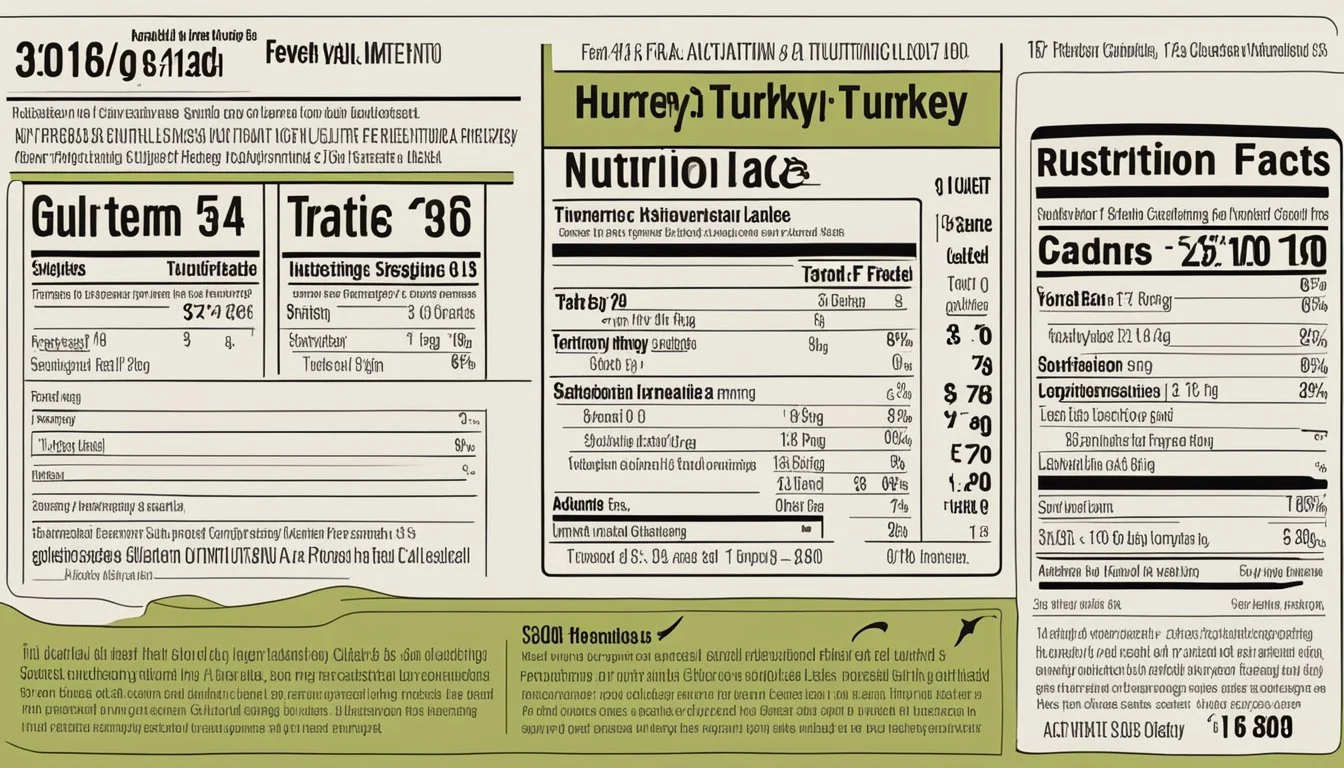How to Reheat Gluten-Free Turkey Meatloaf
Expert Tips for Perfect Results
Reheating gluten-free turkey meatloaf doesn't have to compromise its deliciousness or nutritional value. To enjoy your turkey meatloaf as if it was freshly made, preheat your oven to 350°F and bake the slices for about 20 minutes, or until the internal temperature reaches 165°F. This ensures the meatloaf remains moist and flavorful.
If you're in a rush, the microwave is also a viable option. Place the meatloaf slices on a microwave-safe dish, cover with a damp paper towel, and heat on medium power in one-minute increments until heated through. This method ensures that the gluten-free ingredients remain tender and don't dry out.
For a slightly crispy texture, consider using an air fryer. Set it to 350°F and heat the slices for 8-10 minutes, checking halfway through. This not only warms the meatloaf but also adds a pleasant crispiness to the exterior, enhancing the overall eating experience.
Understanding Gluten-Free Meatloaf
Gluten-free turkey meatloaf offers a healthy alternative to traditional recipes while ensuring that those with gluten sensitivities can enjoy a delicious meal. This section highlights the definition of gluten-free ingredients and the benefits of choosing gluten-free turkey meatloaf.
Defining Gluten-Free
Gluten is a protein found in wheat, barley, and rye. Gluten-free foods exclude these grains and their derivatives. People with Celiac disease or gluten intolerance must avoid gluten to prevent health issues like inflammation and digestive problems.
Ingredients like gluten-free bread crumbs or gluten-free panko replace traditional breadcrumbs. These alternatives ensure the meatloaf holds together without including gluten. The use of gluten-free oats is also common in these recipes.
Benefits of Gluten-Free Turkey Meatloaf
Gluten-free turkey meatloaf caters to dietary needs, offering benefits beyond just being a meatloaf. For those with Celiac disease, eating gluten-free removes the risk of adverse reactions. Moreover, gluten-free ingredients can often lead to more nutritious meals as they eliminate refined grains.
Using ground turkey instead of beef reduces the fat content, making the dish leaner and healthier. Incorporating ingredients like egg whites and gluten-free oats boosts the protein level and fiber content, enhancing the meal's nutritional profile.
In summary, gluten-free options like turkey meatloaf provide safe, nutritious, and delicious choices for those needing to avoid gluten.
Ingredients for Gluten-Free Turkey Meatloaf
Creating a flavorful and moist gluten-free turkey meatloaf requires selecting quality ingredients. It involves ground turkey, suitable binding alternatives, and additional flavor enhancers to ensure a delicious outcome.
Selecting the Right Turkey
Choosing ground turkey is crucial for a moist meatloaf. Opt for ground turkey with higher fat content for more juiciness. Lean turkey can be used, but it may lead to a dryer texture. It is also essential to ensure the turkey is fresh or freshly thawed. Buying from a trusted source guarantees quality and safety.
Gluten-Free Binding Alternatives
To bind the meatloaf without gluten, consider these alternatives:
Gluten-Free Breadcrumbs: They mimic traditional breadcrumbs well.
Oats: Use certified gluten-free oats for added texture and fiber.
Quinoa: Cooked quinoa offers a nutrient-dense option and a slightly nutty flavor.
Egg Replacer: Essential for those avoiding eggs, it maintains the structure.
These alternatives prevent the meatloaf from falling apart while catering to gluten-free diets.
Additional Flavor Enhancers
Enhancing the flavor of turkey meatloaf involves the right seasonings and liquids:
Onion and Garlic: Freshly chopped onions and garlic add robust flavor.
Herbs and Spices: Italian seasoning, basil, or any preferred mix works well.
Roasted Red Peppers: Adds a sweet note to the dish.
Ketchup and Worcestershire Sauce: Provides a savory and tangy balance.
Milk or Dairy-Free Alternative: Keeps the meatloaf moist and tender.
Employing these ingredients ensures a rich and savory gluten-free turkey meatloaf.
Preparation Before Reheating
Proper preparation ensures that your gluten-free turkey meatloaf remains moist and flavorful. Key considerations include optimal storage techniques and steps to prevent dryness during reheating.
Storage Tips
When storing leftover gluten-free turkey meatloaf, it's important to maintain its freshness. Place the meatloaf in an airtight container to prevent exposure to air, which can dry it out. For short-term storage, the refrigerator is ideal. Store it in the fridge for up to 3-4 days.
If you plan to keep the meatloaf for a longer period, use the freezer. Wrap the meatloaf tightly with plastic wrap or aluminum foil before placing it in a freezer-safe bag or container. Label the container with the storage date. For the best quality, frozen meatloaf should be consumed within 2-3 months.
Countering Dryness Pre-Reheat
To keep the meatloaf moist during reheating, take a few preparatory steps. Add a small amount of broth or water to the dish before reheating. This helps retain moisture. For oven reheating, preheat your oven to 250 degrees Fahrenheit. Place the slices in a baking dish and cover them with aluminum foil.
If using a microwave, consider using medium power settings (50-70%). Reheat in short intervals of 1-2 minutes to avoid overheating. For air fryer reheating, preheat the air fryer to 350°F, lightly coat the slices with cooking spray, and heat for 3-4 minutes, monitoring closely to prevent drying.
Reheating Techniques
Reheating gluten-free turkey meatloaf can be done effectively using different methods to maintain its moisture and flavor. Below are the techniques you can use to ensure the best results.
Oven Method
Step 1: Preheat your oven to 250 degrees Fahrenheit (120°C). This low temperature helps prevent the meatloaf from drying out.
Step 2: Lightly coat an oven-safe baking dish with cooking spray or line it with aluminum foil. Place your leftover turkey meatloaf slices in a single layer inside the prepared dish.
Step 3: Add 1-2 tablespoons of broth or water to the dish. This helps retain moisture.
Step 4: Cover the dish tightly with aluminum foil. This traps moisture, preventing the meatloaf from becoming dry.
Step 5: Place the covered dish in the preheated oven and reheat for 25-30 minutes, or until the internal temperature reaches 165 degrees Fahrenheit. Use a meat thermometer to check the temperature.
Microwave Method
Step 1: Place your leftover turkey meatloaf slices on a microwave-safe plate. Cover the meatloaf with a damp paper towel to keep it moist.
Step 2: Set your microwave to medium power (50-70%). This prevents the meatloaf from overheating and becoming rubbery.
Step 3: Reheat the meatloaf in short intervals, starting with 1-2 minutes. Check after each interval to ensure it’s evenly warmed. The goal is to get the internal temperature to 165 degrees Fahrenheit.
Step 4: Use a fork to test the texture. If it feels dry, add a small amount of water and cover it again. Continue reheating in intervals until fully heated.
Stovetop Method
Step 1: Place a non-stick skillet on the stove and set to medium heat. Add a small amount of broth or water to the skillet.
Step 2: Place the turkey meatloaf slices in the skillet. Cover the skillet with a lid to lock in moisture.
Step 3: Reheat the meatloaf for about 5-7 minutes, flipping occasionally. Ensure the slices heat evenly.
Step 4: Check the internal temperature with a meat thermometer. It should reach 165 degrees Fahrenheit.
Step 5: If the meatloaf starts to dry out, add additional broth or water as needed. Use a fork to test the moisture level during the reheating process.
Ensuring a Perfectly Reheated Meal
A successful reheated gluten-free turkey meatloaf must be delicious, moist, and evenly heated. Proper techniques help maintain flavor and texture while ensuring food safety.
Checking for Proper Heat Distribution
Proper heat distribution guarantees that the meatloaf is warmed evenly throughout. To achieve this:
Preheat the oven to 250°F (120°C).
Place the meatloaf in an oven-safe dish and cover it with aluminum foil. This will help retain moisture and promote even heating.
Use a meat thermometer to ensure the internal temperature reaches 165°F (74°C) when reheating. This is crucial for both safety and maintaining optimal texture.
Allow the meatloaf to rest for a few minutes after reheating before cutting into it. This ensures the juices redistribute properly throughout the meatloaf.
Heating meatloaf in a microwave requires frequent checks due to its varying power settings. Reheat in 1-2 minute intervals and use medium power (50-70%). After each interval, check the internal temperature until it safely reaches 165°F (74°C).
Maintaining Moisture and Flavor
Maintaining moisture and flavor is critical to a satisfying reheated meatloaf experience.
Add 1-2 tablespoons of water, beef broth, or even a meat sauce over the meatloaf before reheating. This prevents the meat from drying out and adds depth to the flavor.
If using a microwave, place a cup of water alongside the meatloaf to keep the air moist, which helps maintain the meatloaf’s succulence.
Another effective method is steaming the meatloaf using a steaming basket over simmering water. This method keeps the meatloaf moist and preserves its flavors.
When using an air fryer, reheat the meatloaf on a low-temperature setting. The air fryer’s crisper plate can help maintain texture without drying out the meat.
Serving Suggestions and Pairings
Reheating gluten-free turkey meatloaf offers a range of opportunities to enhance your meal with perfect side dishes and appropriate sauces. Here are some ideas to elevate your dining experience.
Complementing Side Dishes
Pair your reheated gluten-free turkey meatloaf with classic and comforting sides. Mashed potatoes are an excellent choice, providing a creamy and smooth texture that contrasts well with the meatloaf.
Alternatively, steamed or roasted vegetables such as broccoli, carrots, or green beans add a healthy and colorful touch to your plate.
Rice pilaf or quinoa can serve as additional gluten-free options that are both light and satisfying. For a touch of freshness, consider including a crisp green salad with a tangy vinaigrette.
Appropriate Sauces and Glazes
Adding the right sauce or glaze can enhance the flavors of your gluten-free turkey meatloaf. Ketchup is a traditional favorite, offering a sweet and tangy kick that complements the savory meatloaf.
For a richer flavor profile, BBQ sauce can be a bold and delicious choice. Consider a Worcestershire glaze for a umami-packed option that adds depth.
Homemade mushroom gravy can also provide a hearty and satisfying finish. Whether you prefer classic or adventurous flavors, selecting the right sauce can elevate your meal.
Post-Reheat Tips
Ensuring that your gluten-free turkey meatloaf remains delicious and safe to eat requires careful management of leftovers. Additionally, repurposing the meatloaf creatively can help reduce food waste and keep meals interesting.
Leftover Management
Properly handling leftovers is crucial for both quality and safety. Refrigerate any uneaten meatloaf within two hours of cooking to prevent bacteria growth. Store it in an airtight container to maintain moisture and flavor.
Label the container with the date to keep track of how long it has been stored. Leftover turkey meatloaf can typically be kept in the refrigerator for 3-4 days.
For longer storage, consider freezing. Slice the meatloaf and wrap each piece in plastic wrap or foil before placing them in a freezer-safe bag. Frozen meatloaf can last up to 2-3 months.
Creative Leftover Recipe Ideas
Transforming leftover turkey meatloaf into new dishes can enhance meal variety. Meatloaf Sandwiches are a popular choice. Simply slice the meatloaf and layer it with your favorite condiments and veggies between slices of gluten-free bread.
Another option is meatloaf hash. Cut the meatloaf into small cubes and sauté with diced potatoes, onions, and peppers.
Mini meatloaf sliders can also be fun and easy. Use small gluten-free rolls and add toppings like coleslaw, pickles, or cheese.
Turning leftovers into mouthwatering recipes can breathe new life into your meals and ensure nothing goes to waste.
Nutritional Information
The nutritional content of gluten-free turkey meatloaf can vary based on the specific ingredients used. Gluten-free turkey meatloaf typically has fewer calories and allergens than its traditional counterparts, offering a nutritious option.
Caloric Considerations
Gluten-free turkey meatloaf is generally lower in calories compared to meatloaf made with beef.
A typical serving (about 150-180 grams) contains:
Calories: 200-250
Protein: 20-25 grams
Fat: 10-15 grams
This variation takes place due to differences in recipes, such as the use of lean ground turkey and other low-fat ingredients. Adding ingredients like gluten-free bread crumbs, oats, and egg replacers can influence caloric content slightly but still provides a wholesome meal.
Allergen Advice
For those with food sensitivities, gluten-free turkey meatloaf is a viable option.
Turkeys themselves are naturally gluten-free. Gluten-free bread crumbs or oats replace traditional bread crumbs, making it suitable for gluten-intolerant individuals. Common allergens to watch out for:
Eggs: Can be replaced by egg replacers or flaxseed meal to accommodate egg allergies.
Dairy: Most recipes are dairy-free, but it’s crucial to check the sauces and binders used.
For safe consumption, always verify ingredient labels to avoid cross-contamination and ensure all components are allergen-free.









